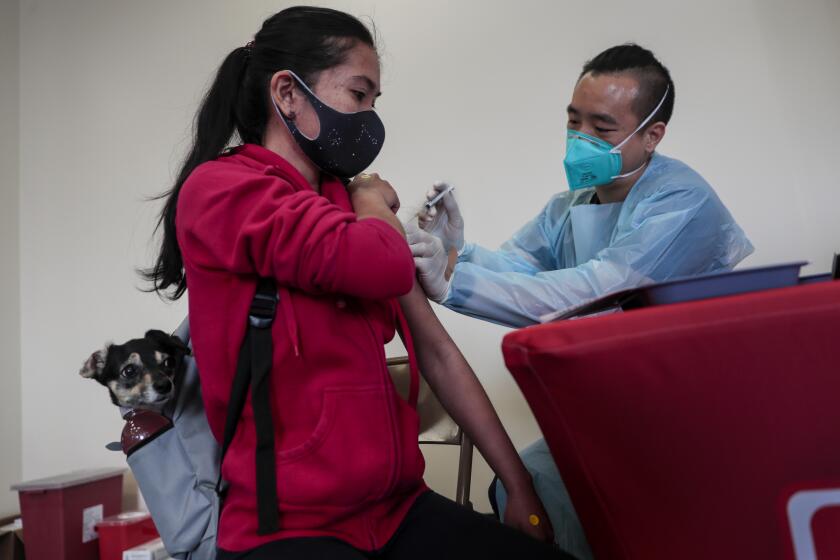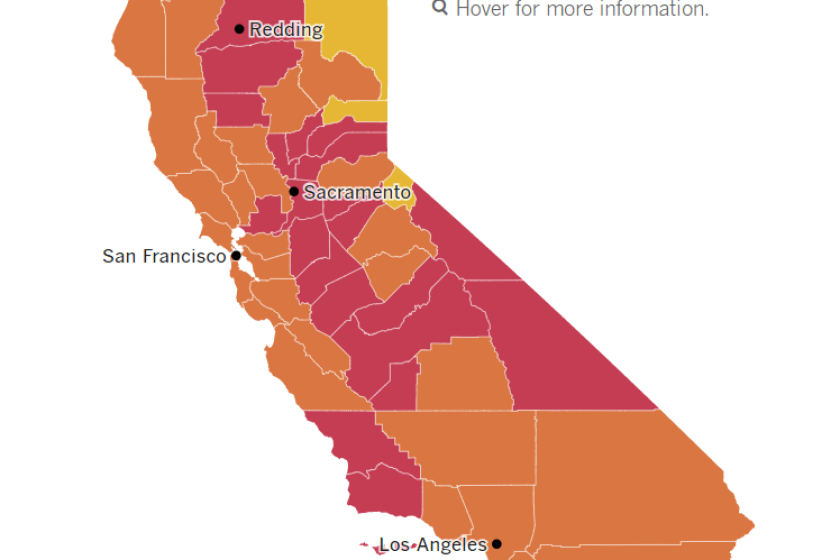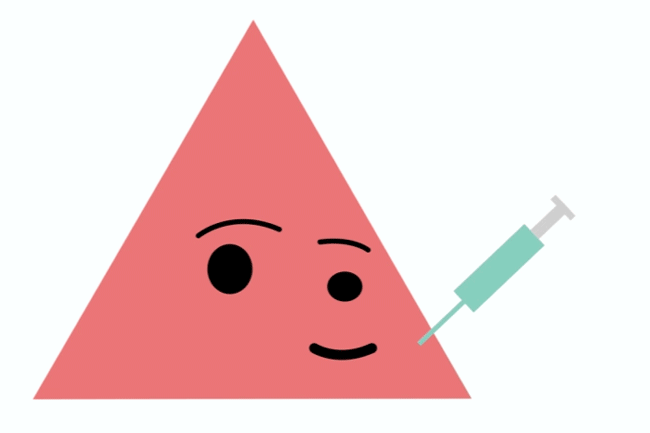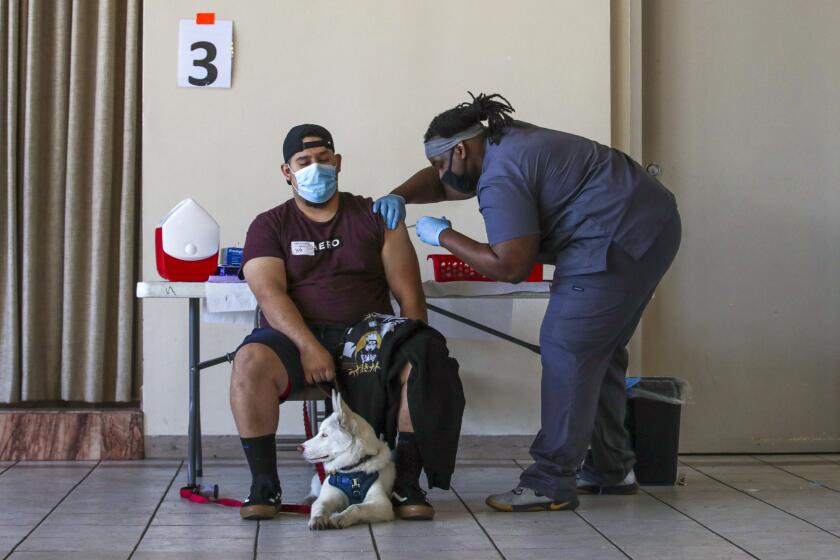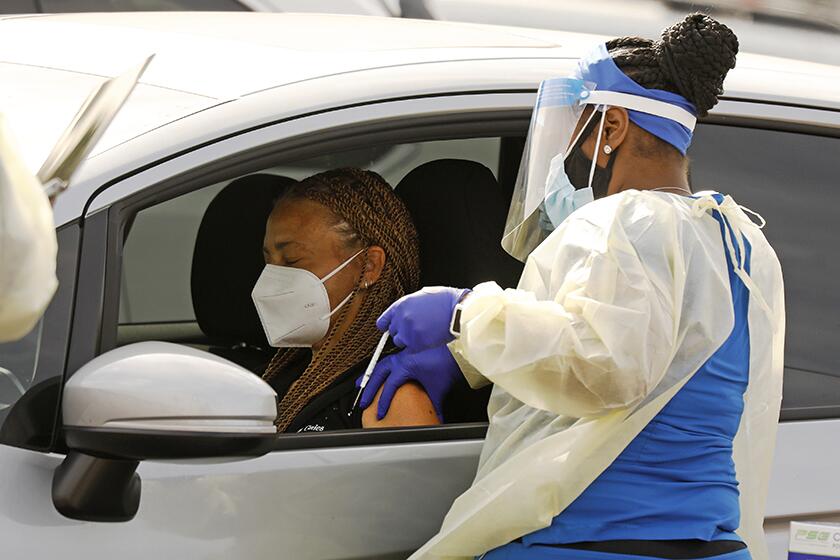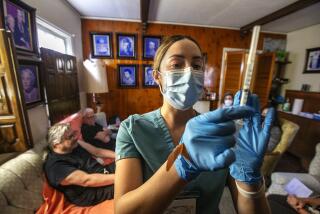All Californians 16 and over can now get COVID-19 vaccine. Here’s how

Speaking at a church in the Bay Area town of Union City, Gov. Gavin Newsom noted that “April 15 officially in 2021 in the state of California is not tax day, it’s vax day.”
- Share via
In another milestone in the race to armor California against COVID-19, all residents 16 and older are now eligible to sign up to be vaccinated.
The move, a pivotal moment in California’s long-running battle against the pandemic, clears away the last remaining barrier to widespread adult access to the precious doses.
As Gov. Gavin Newsom put it, April 15 isn’t tax day in California this year, it’s “vax day.”
“We are looking forward to getting more vaccines in more arms for one fundamental reason: It saves lives,” he said during a news conference Thursday. “These vaccines are safe. These vaccines are effective. These vaccines will get our kids safely back in person in school. These vaccines will quickly and safely get our economy moving again in a sustainable way, getting our small businesses back up on their feet.”
Everyone 16 or older in California can now book COVID-19 vaccination appointments on the state’s My Turn system.
Now, the countdown is on to June 15 — the target the state has set to fully reopen its economy. But getting there, officials say, will require many more Californians to be inoculated against the disease.
That effort was seemingly dealt a blow this week when the state paused using the Johnson & Johnson vaccine following the recommendation of federal health agencies, but California officials say that stoppage is not expected to have a major impact, at least over the next few days.
But even with vaccines becoming more widely accessible, health officials emphasize that COVID-19 remains a dangerous — and deadly — disease, and that residents should continue to take steps to keep themselves, their families and their neighbors safe until more people can be inoculated.
“We’re in the fourth quarter, unquestionably, but this game’s not done yet,” Newsom said. “And we can’t spike the ball ... and we sure as hell can’t lay claim to ‘mission accomplished.’”
Officials moved the lone remaining occupant of the category, Merced County, into the less-stringent red tier after reexamining the region’s data.
Here is what you need to know:
Signing up
Officials released a new version of the My Turn appointment system Wednesday night, which reflects the expanded eligibility, and are in the process of adding language support for the first time in Arabic and Persian.
People can also make appointments by calling (833) 422-4255. Support is offered for more than 200 languages. The hotline is open from 8 a.m. to 8 p.m. Monday through Friday and from 8 a.m. to 5 p.m. Saturday and Sunday.
In Los Angeles County, those with disabilities or without computer access are encouraged to call (833) 540-0473 between 8 a.m. and 8:30 p.m. Monday through Sunday.
My Turn officials said that the online system can handle up to 300,000 transactions per hour, and that they expect it will be able to deal with demand.
All vaccines are free to everyone living in the U.S., regardless of immigration or health insurance status.
You’ve gotten your first COVID-19 vaccination appointment. Try out these scenarios to see if you know how to live post-vaccine.
What to expect
Authorities are advising patience for residents seeking appointments, suggesting it will take some time for everyone who wants a vaccine appointment to get one.
My Turn is meant to serve as a gateway to find and schedule appointments, but sometimes, not all available appointments show up in the system.
Alternate ways to book appointments include through healthcare providers, such as Kaiser, and pharmacies that offer vaccines, such as CVS, Ralphs, Rite Aid, Walgreens, Costco, and Albertsons/Vons/Safeway/Pavilions.
Some of those vaccine providers also began allowing those newly eligible to book appointments on Wednesday night.
The city of Los Angeles has a separate vaccine appointment portal, operated by Carbon Health, that is not integrated into the My Turn system.
After more than a year of the COVID-19 pandemic, close physical contact has become anything but routine. Here are some stories of first post-vaccine hugs.
California is making progress
Nearly 24 million doses have been administered throughout the state, and 22% of residents have been fully vaccinated.
Nationwide, 37.3% of Americans have received at least one dose, and 23.1% are fully vaccinated, according to data from the Centers for Disease Control and Prevention.
“We are making progress. We’re going to defeat this disease. We’re going to end this pandemic,” Newsom said. “There’s a bright light at the end of the tunnel, but we still have more work to do.”
A number of those in California’s newly eligible age range have already received at least one shot because of where they live, their occupation or underlying health conditions.
In L.A. County, where nearly 2 million residents have been fully vaccinated, about 1.5 million residents ages 16 to 49 have received at least one dose. That’s more than a third of that subset.
A major concern early on was that underserved, poorer communities were getting much less vaccine than more affluent ones.
But a new Times data analysis found that Los Angeles County has made significant strides in administering COVID-19 vaccines in communities of color hardest hit by the pandemic, though those areas continue to lag far behind both wealthier neighborhoods and the county as a whole.
Some neighborhoods in South Los Angeles — where the spread of the coronavirus was particularly devastating — saw the biggest increase in how many of their residents had received at least one vaccine dose between March 1 and Monday, the data show. Other areas that saw major improvement include Thai Town in Hollywood, Lennox and Cudahy.
However, despite the gains, these areas are still seeing vaccine rates below the county average.
In each of the 10 communities that has experienced the largest relative gains over the last six weeks, the share of the population age 16 and older that has received at least one vaccine dose remains under 30%. By comparison, 37.1% of L.A. County residents 16 and older had received at least one vaccine dose as of April 4, according to public health data.
“Let’s keep our guard up. Let’s take this moment seriously,” Newsom said. “This is an exciting and proud day because now we have lifted that burden and that anxiety around age and conditions and availed every Californian 16 and over the opportunity to get these vaccines. But now, the hard work is inside of each and every one of you to manifest that ideal — to get us to June 15, to get us past this pandemic and back to a sense of normalcy.”
Among communities with at least 5,000 residents, those that saw the largest relative increases in their vaccination rates over a weeks-long stretch ending Monday were lower-income areas with predominantly non-white populations.
J&J pause is not a barrier — for now
Though California is currently holding off on administering doses of the Johnson & Johnson vaccine while federal health officials investigate reports of six serious blood clot cases nationwide, state officials have said they don’t expect that interruption will throw a major wrench in the inoculation campaign, at least for now.
California state epidemiologist Dr. Erica Pan said less than 4% of California’s vaccine allocation from the federal government this week — 67,600 out of roughly 2 million doses — is from Johnson & Johnson. The vast majority of doses are from the other available vaccines, Moderna and Pfizer-BioNTech.
Newsom characterized the Johnson & Johnson pause as a “temporary setback” but said California anticipates increasing supplies of Pfizer and Moderna to help fill the gap.
He also pointed out that there are a number of supply streams flowing into the state. On top of California’s direct allocation, expected to be about 1.9 million total doses this week, Newsom said he anticipates up to 1.5 million more doses will be delivered to other vaccination sites supported directly by the federal government, such as qualified health clinics and pharmacies.
“From my perspective, I don’t care where you get it; I just want you to get it,” he said. “I don’t care how you get it; I just want you to get it safely.”
Of the 19,600 Johnson & Johnson vaccine appointments that were scheduled this week in Los Angeles County, Public Health Director Barbara Ferrer said that roughly 13,670 have been rebooked for Pfizer-BioNTech or Moderna appointments.
The pause, however, has affected several mobile teams in the county, who often vaccinate people during single-day events. The single-shot dose has been key to the state’s distribution strategy to reach communities hardest hit by COVID-19, as well as residents who are hesitant, less mobile or disabled.
California and Los Angeles officials say they don’t expect the Johnson & Johnson stoppage will make it harder right away to get a COVID vaccine.
The pause in the Johnson & Johnson vaccine was recommended as federal officials investigate six cases involving women ages 18 to 48 who developed a rare blood clot between six and 13 days after receiving the vaccine. One death has been reported.
The presentation of the blood clots reported is particularly rare — involving not only a blood clot that prevents blood from draining out of the brain, known as cerebral venous sinus thrombosis, but occurring in combination with a low level of blood platelets, known as thrombocytopenia. The reports are similar to rare reports of blood clots seen in Europe after vaccination with the AstraZeneca vaccine, which has not been approved in the U.S.
Of the more than 194 million COVID-19 vaccine doses administered nationally, 7.5 million have been of the Johnson & Johnson shot. More than 100 million Pfizer doses and 86 million doses of Moderna have been administered.
Johnson & Johnson is a single-shot vaccine. Both Pfizer and Moderna require two doses, administered weeks apart.
More to Read
Sign up for Essential California
The most important California stories and recommendations in your inbox every morning.
You may occasionally receive promotional content from the Los Angeles Times.
